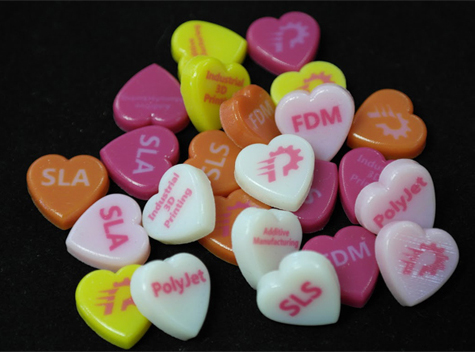There are two characteristics that stand out most about the PolyJet 3D printed pieces—multi-material formats and super high-impact color.
 With 46 colors in each of the nearly two-dozen palettes available, the color capabilities of the Objet500 Connex3 Poly Jet professional 3D printer offer the most versatility of any additive manufacturing process. For visually stunning prototypes or parts that require exceptionally differentiated elements, PolyJet delivers the most pigments with precision. There are some intricacies to the process that are important to understand for both design and budgeting, though.
With 46 colors in each of the nearly two-dozen palettes available, the color capabilities of the Objet500 Connex3 Poly Jet professional 3D printer offer the most versatility of any additive manufacturing process. For visually stunning prototypes or parts that require exceptionally differentiated elements, PolyJet delivers the most pigments with precision. There are some intricacies to the process that are important to understand for both design and budgeting, though.
Digging into the details in advance will smooth the quoting and production process and ensure your PolyJet project is fast, cost effective and, aesthetically, everything you need.
How PolyJet Color Works
Color is an integral part of the actual PolyJet process— unlike other techniques like urethane that is mixed and pigmented or SLA/SLS which are built in a base color then painted. Projects can incorporate as many of those 46 colors as needed in a single part. Additionally, PolyJet materials and pigments are interdependent so there are no limitations on the size, shape or durometer of the various colored areas—if it is within build guidelines for the machine, it can be created in just about any color.
The key is in how the PolyJet machine combines materials. The Objet500 Connex3 has three tanks that can be filled with base resins and mixed in specific concentrations to produce both a multitude of hues and shore values. Similar to the CMYK color cartridges on a paper printer, PolyJet mixes colors from the three tanks to create the various tints.
Unlike 2D printing, however, multi-material 3D projects also rely on those three base resins to create the various blended materials with different durometers meaning color selection impacts what kind of textures are achievable. With 46 possible colors in each palette, there is certainly no shortage of options.
Choosing a Palette
Choosing a palette requires assessing the durometer needs of the project first—both rigid palettes and flexible palettes each have their own individual spectrum. There are a total of 13 available rigid palettes and six flexible palettes with a huge range of available shades and hues.
For projects requiring both rigid and flexible pieces in one part, builds are based on a flexible palette. Shore values are noted per color—low shore values are more flexible, high shore values are more rigid, and, for “clear” palettes, the more transparent a color, the softer it is. Multi-material projects do have fewer available color selections for the rigid areas than if the part where all rigid as color is limited by what the material combination can accommodate.
Although PolyJet 3D professional printing is renown for creating striking complex parts, the process can actually produce simpler single-material parts quickly and cost effectively. Time is money with it comes to additive manufacturing and digitally-blended projects require a longer lead time and are, therefore, more expensive than those using just a straight color in a native material.
Design Tips
Designing specifically with the PolyJet 3D professional printing method in mind would result in collaborative life-cycle concept-to-production process. In just such an ideal situation, the available palettes would be the starting point and help inform design. In reality, however, this is rarely the case. An engineer or designer usually has something particular in mind and looks for the production process that is most likely to get them there.
For example, ProtoCAM does prototypes for a particular company with a corporate color. We used to have to add a finishing process to their projects that involved careful mixing and painting to get it just right. With PolyJet, we can directly print the part in an approximation of their trademarked orange.
Two important things to remember:
- Each color requires it’s own design file. Every color needs a support or a shell so each color component must have it’s own design file with coordinates. Typically ProtoCAM receives assembly files that include a composite with each part called out.
- PolyJet colors are not Pantone. Although the color capabilities of PolyJet 3D professional printing far exceed those of any other additive manufacturing process, they aren’t as limitless as 2D color mixing.
For the vast majority of projects, exact colors are not necessarily essential components of a design—differentiation is really the key to telling the story. Having offsetting colors on the intricate parts of a medical prototype can effectively highlight the end results of that particular design. Printing the internal components of, say, an airflow assembly in different colors can make the concept really pop.
While 3D printing color mixing might not be as nuanced as 2D printing—yet—it can take additive manufacturing projects from simplistic to spectacular, or simply save time (and money).
Browse the PolyJet palettes currently available and the mechanical properties of each. Contact us for more information, or request a quote today.
